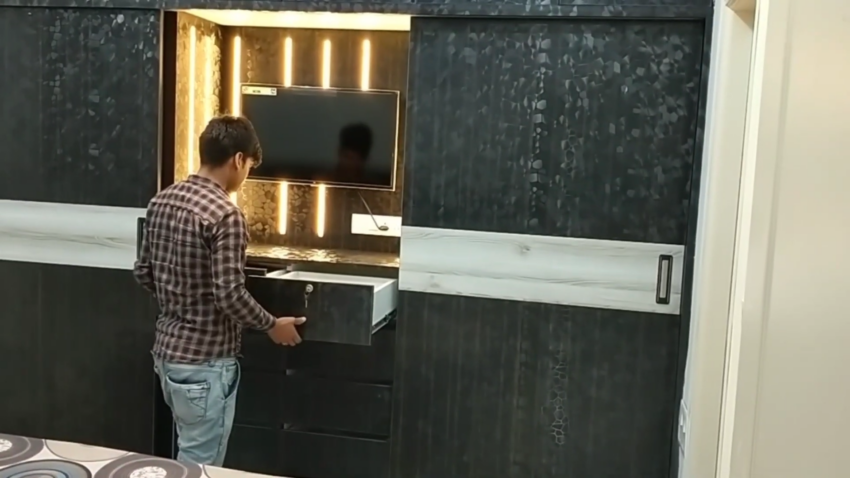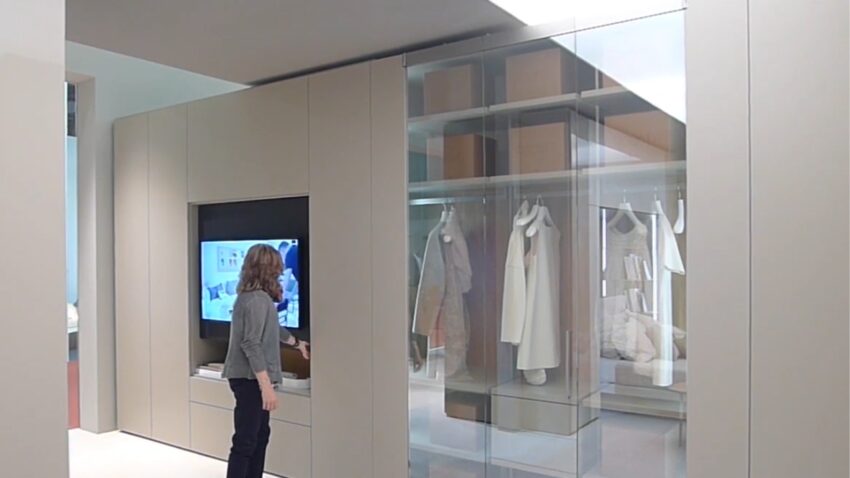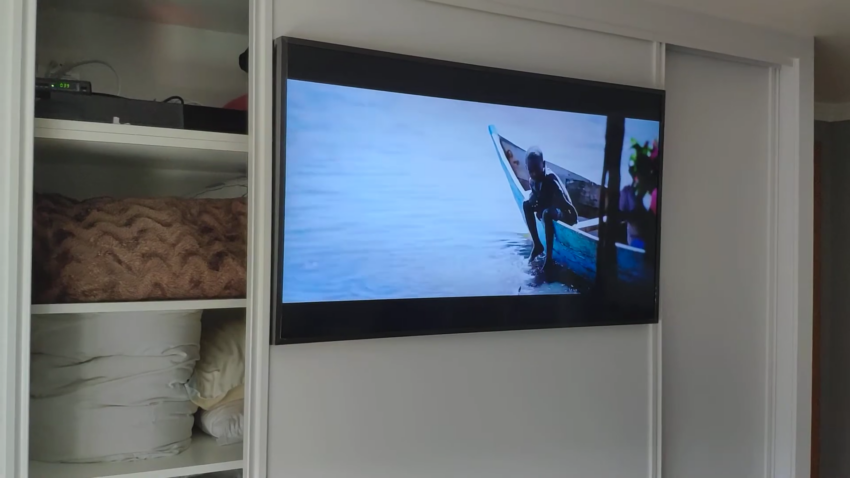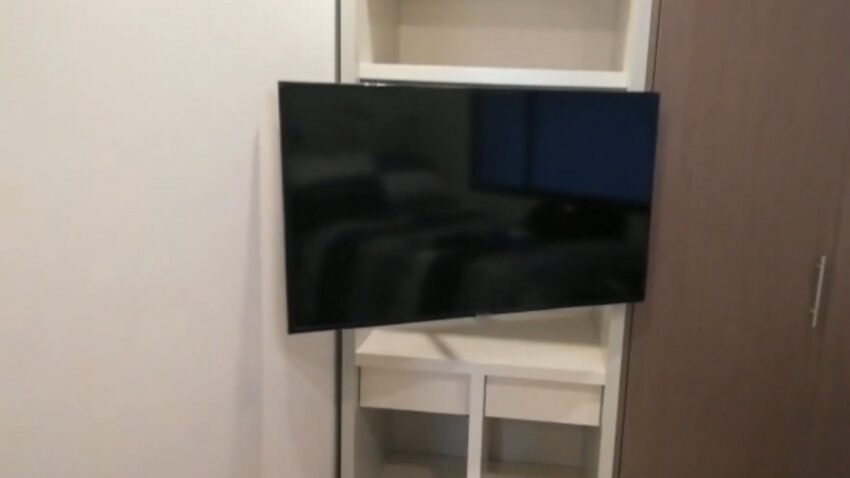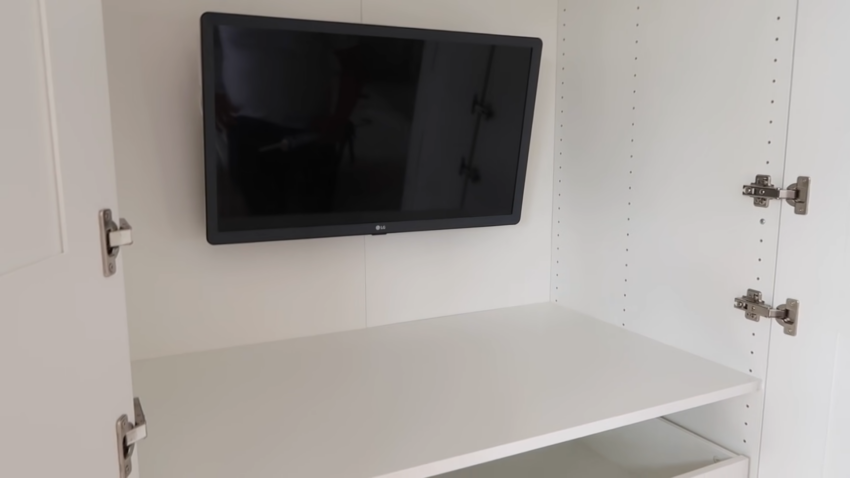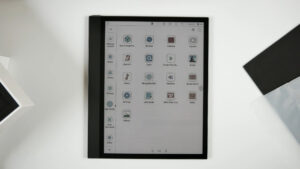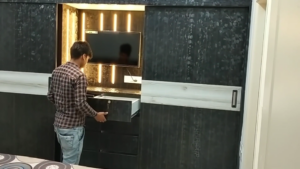Modern home designs increasingly include technology in furniture, like wardrobes with built-in TVs. These wardrobes blend clothing storage with entertainment units to save space and increase convenience.
It’s important to consider their safety and compliance with safety standards specific to combining electronics and storage units.
When installing a TV in a wardrobe, proper planning and professional installation are crucial. Ensuring enough room for wiring and air circulation helps prevent accidents.
The safety of these furniture pieces also relies on regular maintenance and using high-quality materials suitable for safely containing and operating electronic devices in a limited space.
1. Safety Concerns and Precautions
Before you think about adding a TV into a wardrobe, it is essential to prioritize safety. We need to consider structural stability and electrical safety to ensure the amalgamation does not compromise the wardrobe’s functionality or pose risks to its users.
Structural Stability
To keep a wardrobe with a built-in TV structurally sound, consider the weight distribution and support methods. Reinforce shelves and drawers near or under the TV to stop sagging or collapse from extra weight.
Also, ensure the wardrobe’s back panel is strong enough to hold the TV safely. Always follow the manufacturer’s guidelines on weight limits to prevent risks.
Weight Considerations for Shelves and Drawers
- Ensure shelves are robust enough to support the weight of the TV.
- Check drawers for stability; avoid placing heavy items that could unbalance the wardrobe.
Support Mechanisms
- Install proper mounting brackets or stands specifically designed for TV integration within the furniture.
- Regularly inspect the wardrobe for any signs of weakness or wear.
Electrical Safety
When installing electrical components in a wardrobe, handle and install them carefully. Connect the television and other electrical devices to a surge protector to protect against electrical damage. Manage cables well to prevent tripping or wire damage that might cause short circuits or fires.
- Always use a surge protector for the TV and associated electronic devices.
- Keep cables organized and secured away from the areas where drawers and shelves are frequently accessed.
- Inspect wiring regularly for any signs of fraying or damage.
2. Design Considerations for Integration
When we integrate a television into a wardrobe design, careful attention to both compatibility and safety is paramount. The aesthetic and functional aspects must align to ensure a seamless addition to the existing room design.
Wardrobe Design Compatibility
To include a TV in our wardrobes, we need to check their size and how much weight they can hold. This makes sure the wardrobe can safely support a TV.
- A wardrobe must have a recess or dedicated space that is large enough to house the television. This space should accommodate not just the screen size but also any additional equipment, like cables and brackets.
- We must ensure that the wardrobe’s construction can support the weight of the television and related hardware. This might involve reinforcing the wardrobe’s frame or using stronger materials in its construction.
Overall, It should be easy to access the television for maintenance and to use ports and controls. This might involve sliding mechanisms or doors that can be opened fully. If you want to take a look at some sliding doors options, be sure to pay a visit to https://asw-online.com.au/wardrobe-sliding-doors.
3. Maximizing Storage Solutions
When we design a wardrobe with a built-in TV, space maximization is key to a harmonious and accessible environment. The following strategies will ensure practical storage while maintaining a sophisticated aesthetic.
Incorporating Shelves and Drawers
Shelves are fundamental in making the most of vertical space. Our approach prioritizes:
- We incorporate adjustable shelves to cater to different storage needs, allowing for the accommodation of both large and small items.
- Below the TV area, we can install drawers to store smaller, personal items. Using full-extension drawer slides ensures ease of access.
Utilizing Cabinets and Open Shelves
Cabinets offer concealed storage, creating a clean and uncluttered look. We recommend:
- Soft-close hinges are ideal for maintaining the integrity of the built-in wardrobe structure over time.
- Tall cabinets use the full height of the room, maximizing storage space.
Conversely, open shelves offer flexible storage and display options. They enhance accessibility and can make a space feel larger. Here are examples we usually implement:
- Above the TV, they are perfect for items less frequently used.
- These are ideal for displaying decorative items that complement the entertainment system.
4. Cost Analysis
In this section, we will break down the costs associated with wardrobes that feature built-in TVs, comparing them to standard wardrobes and considering the budget implications for additional features.
Price Comparison of Standard vs. Built-In Wardrobes
Exploring wardrobe pricing shows that built-in wardrobes with extras like integrated TVs cost more than standard ones. A standard wardrobe costs less because it has a simpler design and manufacturing process. Adding a TV to a wardrobe needs more materials, a special design, and installation, raising the price.
- Standard Wardrobe: $500 – $2,500
- Built-In Wardrobe with TV: $2,000 – $5,000+
Budgeting for Additional Features
When planning our budgets for a wardrobe installation with a built-in TV, we must account for not only the initial purchase price but also the long-term costs. These may include:
- The added complexity of electrical components can increase maintenance needs.
- Built-in electronics could lead to a slight increase in energy usage.
- Should the TV or its integration into the wardrobe malfunction, repair costs can be higher than those for a standard wardrobe or a standalone TV, due to the specialized nature of the built-in system.
FAQs
Do Built-In Wardrobes Need Ventilation?
Yes, built-in wardrobes need ventilation to stop moisture from building up and causing mold or mildew. It’s crucial to have ventilation when you store electronics, such as a TV, to let heat out.
How Long Do Fitted Wardrobes Last?
Fitted wardrobes usually last between 10 and 20 years. The lifespan changes depending on the material quality, how well they are built, and how they are maintained. Using better materials and building them well can make them last longer.
Which Type of Wardrobe Is Best?
Choose a wardrobe based on your space, style, and budget. Opt for fitted wardrobes to save space and customize, or select freestanding wardrobes for flexibility in moving and rearranging. Ensure you pick strong materials and solid construction for durability and functionality.
Summary
In assessing the safety of wardrobes with built-in TVs, we have considered several key factors. Our findings indicate that while these innovative pieces of furniture can offer style and functionality, safety should not be an afterthought. We are certain you will find this insight of ours useful.


